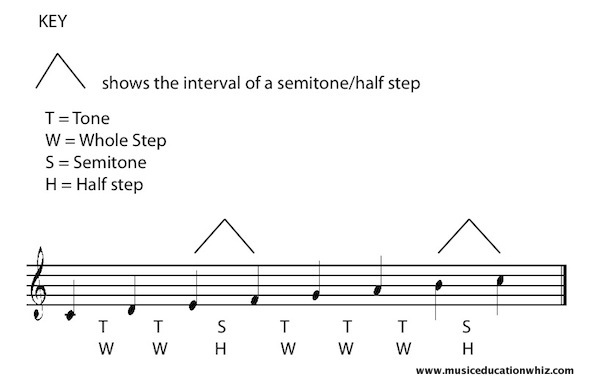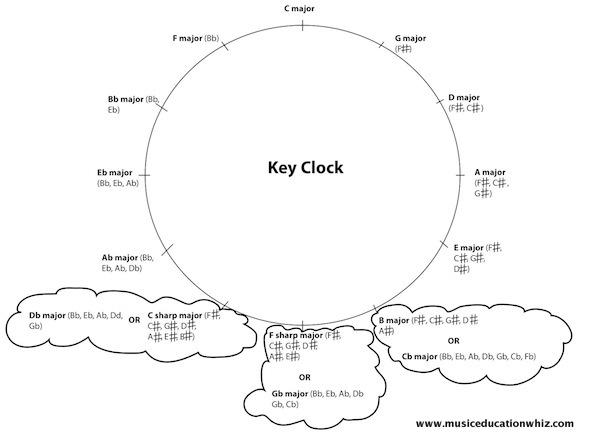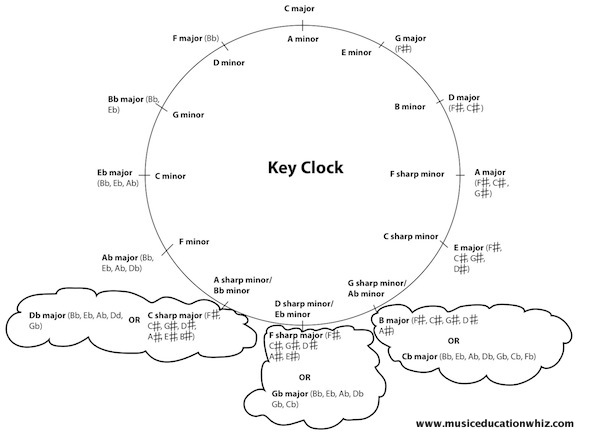Back to andrewdownes.com

Music Education
Resources by Paula Downes, a lot of music by Andrew Downes
Scales and Keys made easy!
On this page:
Scales: Major; Natural, Melodic, Harmonic Minor
Scale Degrees
Scales and Keys
Key Signatures and how to work them out
Use this page to learn about or to teach in a clear and practical way. The diagrams and videos below can be presented on an interactive whiteboard. It is great for the pupils to be able to see the fingers on the keyboard as the scales are played.
Scales
The best way to learn about scales is to learn how to play them. A good place to start is The Complete Book of Scales, Chords, Arpeggios and CadencesWhen we learn to play a musical instrument, we learn to play scales. The reason for this, is that Western Classical music is based on these scales, so if we know the fingering for each scale, we will find it easier to learn the music. There are four different types of scales:
Scales sound the way they do because of the
organization of tones (UK)/whole steps (USA) and semitones (UK)/half steps
(USA).
The major scale has the following series of tones/whole steps and semitones/half
steps:
Tone, Tone, Semitone, Tone, Tone, Tone
Semitone
OR
Whole Step, Whole Step, Half Step, Whole
Step, Whole Step, Whole Step, Half Step
Here is the scale of C major:
The natural minor scale has the following series of
tones/whole steps and semitones/half steps:
Tone, Semitone, Tone, Tone, Semitone, Tone,
Tone
OR
Whole Step, Half Step, Whole Step, Whole
Step, Half Step, Whole Step, Whole Step
Here is the scale of C natural minor:

The melodic minor scale is different
ascending (going up), from descending (going down). The descending version is the same as the natural minor. Here is the series
of tones/whole steps and semitones/half steps in a melodic minor scale:
Ascending:
Tone, Semitone, Tone, Tone, Tone, Tone,
semitone
OR
Whole Step, Half Step, Whole Step, Whole
Step, Whole Step, Whole Step, Half Step
Descending:
Tone, Tone, Semitone, Tone, Tone, Semitone,
Tone
OR
Whole Step, Whole Step, Half Step, Whole
Step, Whole Step, Half Step, Whole Step
Here is the scale of C melodic minor:

The harmonic minor scale has the following
series of tones/whole steps and semitones/half steps:
Tone, Semitone, Tone, Tone, Semitone, Augmented second (3 semitones), Semitone
OR
Whole Step, Half Step, Whole Step, Whole
Step, Half Step, Augmented second (3 half steps), Half Step
Here is the scale of C harmonic minor:

Return to the top of the page
Scales and Keys: Scale Degrees
Each note of a scale is called a 'scale degree' and is labelled with a Roman Numeral and a name. These labels are always the same, no matter what key you are in:
Scale Degree Name
I Tonic
II Supertonic
III Mediant
IV Subdominant
V Dominant
VI Submediant
VII Leading Note (Subtonic in the natural minor)
Interesting facts:
'Super' is the Latin for above, 'sub' is the Latin for below; the mediant is a 3rd above the tonic, the submediant a third below; the dominant is a fifth above the tonic, the subdominant is a fifth below the tonic; the leading note leads towards the tonic since it is only a semitone/half step away.
Return to the top of the page
Scales and Keys
The scale of C major has no black keys in
it, so no sharps or flats. If we try to
play a major scale starting on a different note, we will need to add some black
notes in order to keep the pattern of tones/whole steps and semitones/half
steps the same.
Here is the scale of G major:
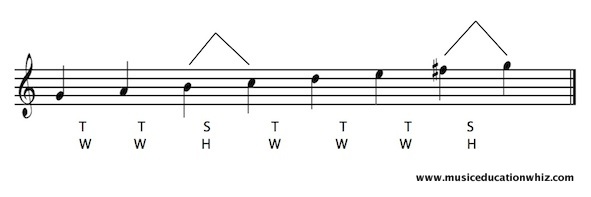
Here is the scale of D major:
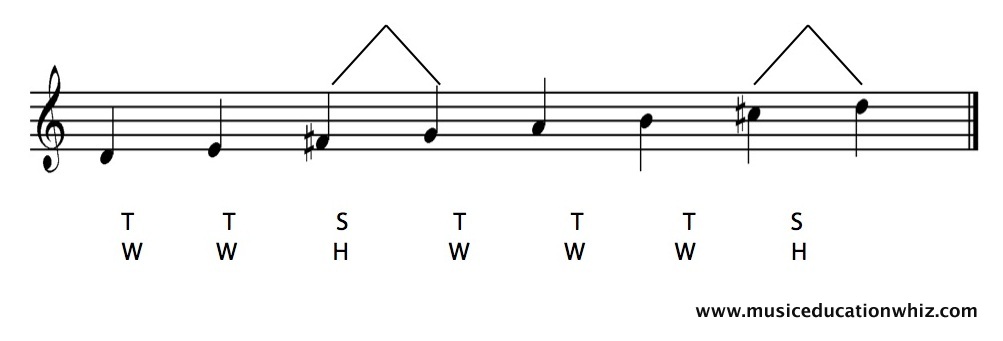
Here is the scale of F major:
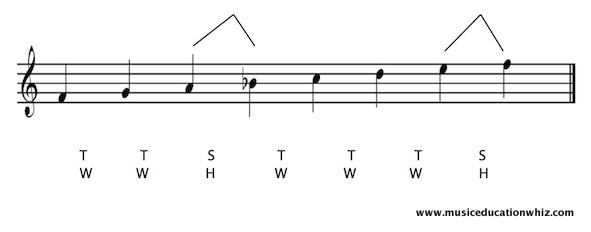
Here is the scale of Bb major:
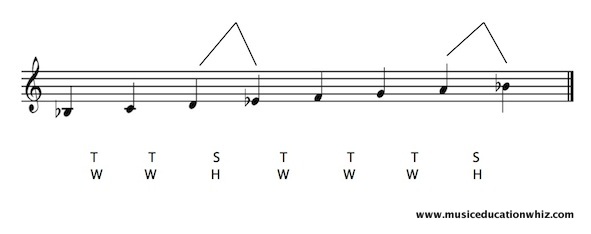
Return to the top of the page
Scales and Keys: Key signatures
Rather than writing sharp and flat signs
against every note that needs one, we can use a key signature at the beginning
of the music like this:
The key of G major:
This tells us that every F in the piece is an F sharp. If you look at the scale of G major above, it has an F sharp in it. We can write the scale out with a key signature instead:
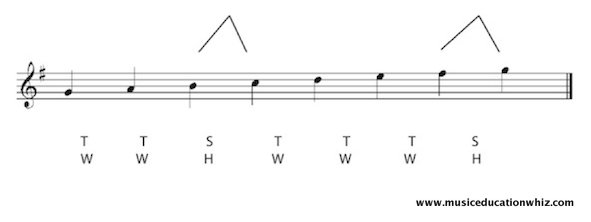
It is a good idea to memorize all key
signatures to help you to play scales and pieces more easily. I will now teach you some methods to help you
to memorize them.
Key Clock
The diagram below is a key clock. C major
is at the top because C major has no sharps or flats. If you move clockwise around the clock, you
will get to G major, which has 1 sharp.
The next one is D major, which has 2 sharps and so on. If you move anticlockwise around the clock,
you will get to F major, which has 1 flat.
The next one is Bb major, which has 2 flats and so on. The Key Clock is also known as a 'Circle of Fifths' because each key is a fifth away from the next key around the clock.
The order of sharps and flats in a key
signature
You will notice that in every key, the
order of sharps or flats is always the same. So if a key signature has 2 sharps, they
will be F and C. If a key signature has
five sharps, the first two will still be F and C.
The order of Sharps
F, C, G, D, A, E, B
An easy way to remember the order of sharps
is to remember this rhyme: Father Charles Goes Down And Ends Battle
The order of Flats
B, E, A, D, G, C, F
An easy way to remember the order of flats
is to say the sharps' rhyme backwards: Battle, Ends and Down Goes Charles’ Father
How
do you work out a key by looking at a key signature?
If you are looking at a key signature containing
sharps, go to the last sharp in the key signature, go up a semitone/half step,
and that is your key. For example, if
you are looking at a key signature containing four sharps, they will be F sharp,
C sharp, G sharp, D sharp. Go up one
semitone/half step from D and you get to E.
Your key is E major.
If you are looking at a key signature with
flats, go to the penultimate (second to last) flat and that is your key. For example, if you are looking at a key
signature containing 5 flats, they will be B flat, E flat, A flat, D flat, G
flat. The penultimate flat is D flat. Your key is D flat major. (NB, you need to just remember that the key with one flat is F major!)
Minor
keys
Minor keys share the same key signatures as
the major keys. A minor key with the
same key signature as a major key is the relative minor. The opposite is also true: a major key with the same key signature as a
minor key is the relative minor. D minor
is the relative minor of F major. C
major is the relative major of A minor.
How
do you work out what the relative minor of a major key is?
You go down a minor 3rd (3
semitones/half steps). For example, if
you have a key signature of 2 sharps, that is the key signature for D
major. Go down 3 semitones/half steps
from D and you get to B. Your relative
minor is B.
How
do you work out what the relative major of a minor key is?
Either look at the key signature, or go up
3 semitones/half steps. For example, if
you are in F minor, go up 3 semitones/half steps and you get to Ab. Your relative major is Ab.
Accidentals
Unless your music is in the natural minor,
not all the notes of a minor key are in the key signature. In the harmonic minor, the 7th
note of the scale is raised a semitone/half step. We call this the raised 7th. This note will not be in the key signature so
it is called an ‘accidental’. It will
have to be written into the music every time that note occurs. In the ascending version of the melodic
minor, the 6th and 7th notes are raised a semitone/half
step. Again, they are ‘accidentals and they
will need to be written into the music every time they occur.
Here is the key clock with all the relative
minor keys around the inside of the clock.
How do you work out whether a piece of music is in a major or a minor key?
First of all, look at the starting and ending notes of the piece. They will most likely be the tonic of your key. Next, look out for accidentals. If you see any and work out that they are the raised 6th and/or 7th of your minor key, that is most likely to be your key.
Return to the top of the Scales and Keys page
Home>Music Theory>Scales and Keys

Music Education
Resources by Paula Downes, a lot of music by Andrew Downes
Back to andrewdownes.com
Follow Cynthia Downes on Instagram to keep up-to-date with her blog posts.
If you have performed in any of Andrew Downes' works or come to listen, please share your experiences in the Premieres Blog! Also see what others have said. Thank you so much for your contribution.
